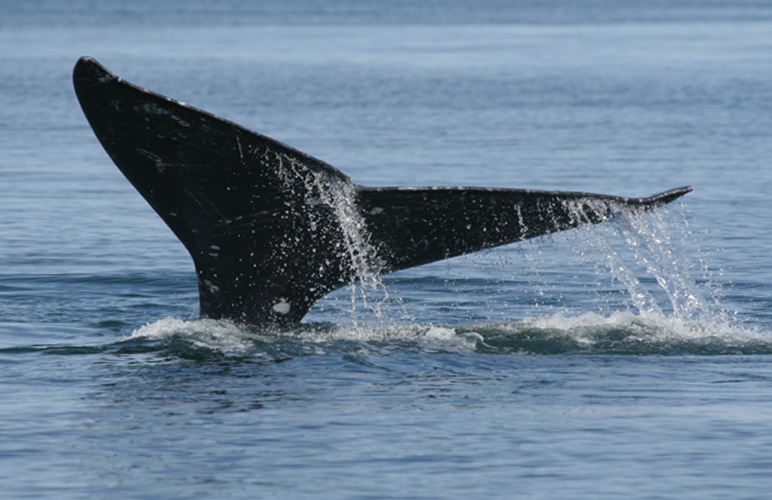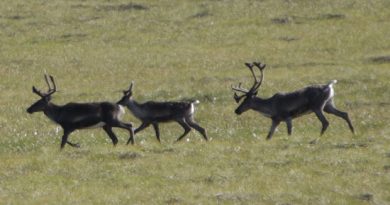Gray whales reach Gulf of Alaska on annual migration north
 The first migrating gray whales have reached Alaska waters. The annual spring jaunt north by thousands of big cetaceans now stretches along nearly 1,800 miles of coast, from southern California to the waters off Sitka.
The first migrating gray whales have reached Alaska waters. The annual spring jaunt north by thousands of big cetaceans now stretches along nearly 1,800 miles of coast, from southern California to the waters off Sitka.
“The parade of northbound Eschrichtius robustus is in full swing,” according to the latest update posted by the educational website Journey North. “Whales in the lead are now passing Canada’s Vancouver.”
The northbound juggernaut included a 9-year-old female gray whale from the critically endangered population that summers in the far western Pacific Ocean.
Nicknamed Varvara, the whale was one of six western grays tagged with tracking devices last summer, and the only one still transmitting. (Journey North also offers its own Varvara primer.)
“This week Varvara traveled from Vancouver Island up to Baranof Island and was offshore from Sitka,” according to the March 25 update posted by scientists at the Marine Mammal Institute of Oregon State University. “This is north of (but close to) her arrival point where she came near shore when she crossed the Gulf of Alaska and then headed south.”
Journey North follows the northward movement American Robins, monarch butterflies and a few other critters and plants, relying on volunteer spotters and school children for most updates. Tracking the eastern Pacific’s gray whale migration toward Alaska’s Arctic seas may be the organization’s marquee event, drawing on dispatches from Southern California to the Aleutian Islands.
The grays are baleen whales that grow up to 50 feet in length and 40 tons in weight on a diet of crustaceans and clams sifted from the sea bottom. Almost driven to extinction by 19th century whaling, the eastern Pacific population has since recovered and may number as many as 20,000 animals. They are one of the most commonly sighted large whales in Alaska’s Pacific waters, an element of Native lore and a mainstay of modern tourism. The 1988 rescue of three gray whales from sea ice off Alaska’s Arctic coast also inspired the new movie, Big Miracle.
Their 10,000-mile round-trip — which will bring them past the mouth of Resurrection Bay off Seward and road-accessible headlands on Kodiak Island in April — may be the longest known annual migration by any mammal. Their range covers almost the entire west coast of North America. (Tours start in about two weeks out of Seward. The Kodiak Whale Fest runs from April 20 to 30.)
To catch a glimpse of this natural wonder as it unfolds, scores of volunteers have been hitting overlooks and venturing offshore in small boats between California and Washington state — filing reports about the 30-ton animals feeding, springing from the sea, mingling with calves and eyeballing humans on boats.
“BREACHERS! 41 GRAYS!,” exclaimed one field note from Point Vicente near Los Angeles, where the American Cetacean Society conducts a long. “One gray whale BREACHED four times; it was part of a pod of five that came in close to shore and milled for over an hour. They were fun to watch: lots of blows, bodies and flukes. Later another whale BREACHED two times, about a half-mile away.”
Since Dec. 1, American Cetacean Society (ACS) volunteers have logged 1,109 gray whales passing offshore — 669 southbound and 440 northbound — including three whales swimming north on Monday, according to the most recent daily census report.
“We are now likely in the middle of the peak of the first northbound migration phase; not cow/calf pairs, who come by in peak numbers about four-to-six weeks later in the second northbound migration phase,” said ACS director Alisa Schulman-Janiger in this post. “Calf counts should begin to increase in number over the next few weeks, usually peaking near the end of April.”
Various Oregon watchers counted 245 whales over the weekend. Further up the coast, near Deception Pass in Puget Sound, observers logged the return of a gray whale nicknamed “Patch,” first identified in that area in 1991 and recognized each year by a large white patch on his right side.
Varvara has fascinated whale watchers since last year. After crossing the North Pacific to Alaskan waters, the young adult female journeyed south along the Pacific Coast, wintered in Baja and has lately been retracing her swim, so to speak, moving north about 100 miles per day. News of her epic trans-hemispheric swim has gotten wide coverage.
The Oregon State team believes Varvara will ultimately swim thousands of miles west toward Sakhalin Island, where the estimated 130 remaining western gray whales spend summers feeding on sea-bottom creatures. This March 16 story posted by OSU offers background and details.
Contact Doug O’Harra at doug(at)alaskadispatch.com
For more stories from Alaska Dispatch, click here.



